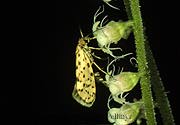Greya mitellae
Olle PellmyrAdult Characteristics
Wing expanse 10-15 mm. This is arguably the most sexually dimorphic species of the genus. It also represents a reversal of the unusual size dimorphism in the genus. Forewings of the larger female are stramineous, and in the smaller male brown to dark yellow and slight purple iridescence in fresh specimens; both sexes marked with small, dark brown spots, usually fewer in number on the female. Hindwings medium to dark gray.
Comparison with Similar Species
Males are unmistakable, whereas females possibly can be mistaken for small indidivuals of the allopatric G. punctiferella. Greya punctiferella is a larger moth with lighter yellow ground color, narrower wings, and smeared spots.
Host, Oviposition, and Larval Feeding Habits
The species feeds exclusively on Mitella stauropetala (Saxifragaceae). Eggs are laid most commonly in leaf stalks, but also in the peduncle and in the floral calyx. The larvae evidently mine in vegetative tissue, but nothing is known about later instars.


G. mitellae nectaring and accidentally pollinating a Mitella flower; notice pollen adhering to proboscis.
Geographic Distribution
Northwestern Idaho and the Blue Mountains of southeastern Washington. Further extension eastward of the host suggests that the moth may have a wider range as well.
Habitat
In moist coniferous or mixed forest, particularly in light gaps where the host tends to flower more luxuriantly. Elevational range 800-1300 m. The species often co-occurs with G. obscuromaculata.


Typical habitat in Latah Co., Idaho.
Ecological Notes
Greya mitellae drinks nectar from the flowers of its host, and experimental studies show that pollen adheres to the proboscis and that the moth causes passive pollination of the flowers. Because few other flower visitors are observed in the habitat of M. stauropetala, this moth may be a very important pollinator to the plant (Pellmyr et al. 1996).
Phylogenetic Notes
In a phylogenetic analysis based on mitochondrial DNA sequence data, G. mitellae was nested within G. piperella (Brown et al 1994). It is evident that speciation of G. mitellae has occurred so recently that the mitochondrial lineages have not yet been assorted. Greya mitellae reflects speciation based on a simultaneous habitat and host shift, and there has been striking morphological evolution particularly in the male.
References
Brown, J.M., O. Pellmyr, J.N. Thompson & R.G. Harrison. 1994. Phylogeny of Greya (Lepidoptera: Prodoxidae), based on nucleotide sequence variation in mitochondrial cytochrome oxidase I and II: congruence with morphological data. Mol. Biol. Evol. 11:128-141.
Davis, D.R., O. Pellmyr & J.N. Thompson. 1992. Biology and systematics of Greya Busck and Tetragma n. gen. (Lepidoptera: Prodoxidae). Smiths. Contrib. Zool. 524:1-88.
Pellmyr, O., J.N. Thompson, J. Brown & R.G. Harrison. 1996. Evolution of pollination and mutualism in the yucca moth lineage. Amer. Nat. 148:827-847.
Title Illustrations

| Scientific Name | Greya mitellae |
|---|---|
| Location | Latah Co., Idaho, USA |
| Specimen Condition | Dead Specimen |
| Sex | Male |
| Image Use |
 This media file is licensed under the Creative Commons Attribution-NonCommercial License - Version 3.0. This media file is licensed under the Creative Commons Attribution-NonCommercial License - Version 3.0.
|
| Copyright |
© 1996

|
| Scientific Name | Greya mitellae |
|---|---|
| Location | Nez Perce Co., Idaho, USA |
| Specimen Condition | Dead Specimen |
| Sex | Female |
| Image Use |
 This media file is licensed under the Creative Commons Attribution-NonCommercial License - Version 3.0. This media file is licensed under the Creative Commons Attribution-NonCommercial License - Version 3.0.
|
| Copyright |
© 1996

|
About This Page

University of Idaho, Moscow, Idaho, USA
Page copyright © 1996
 Page: Tree of Life
Greya mitellae .
Authored by
Olle Pellmyr.
The TEXT of this page is licensed under the
Creative Commons Attribution-NonCommercial License - Version 3.0. Note that images and other media
featured on this page are each governed by their own license, and they may or may not be available
for reuse. Click on an image or a media link to access the media data window, which provides the
relevant licensing information. For the general terms and conditions of ToL material reuse and
redistribution, please see the Tree of Life Copyright
Policies.
Page: Tree of Life
Greya mitellae .
Authored by
Olle Pellmyr.
The TEXT of this page is licensed under the
Creative Commons Attribution-NonCommercial License - Version 3.0. Note that images and other media
featured on this page are each governed by their own license, and they may or may not be available
for reuse. Click on an image or a media link to access the media data window, which provides the
relevant licensing information. For the general terms and conditions of ToL material reuse and
redistribution, please see the Tree of Life Copyright
Policies.
Citing this page:
Pellmyr, Olle. 1996. Greya mitellae . Version 01 January 1996 (under construction). http://tolweb.org/Greya_mitellae/12317/1996.01.01 in The Tree of Life Web Project, http://tolweb.org/










 Go to quick links
Go to quick search
Go to navigation for this section of the ToL site
Go to detailed links for the ToL site
Go to quick links
Go to quick search
Go to navigation for this section of the ToL site
Go to detailed links for the ToL site